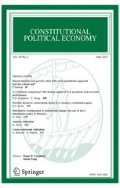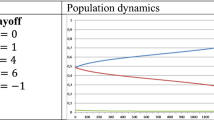Abstract
A hybrid of a model of economic equilibrium in two markets and a social game is formed. The link between the two is established through a social norm that conditions correct social behavior on economic variables and therefore distorts the economic equilibrium allocation. The initial endowment of an individual determines whether she gains from a social norm. The evolution of norms is examined in a dynamic model where norms are more likely to persist if they deliver higher utility to their believers. Also it is assumed that norms lose importance when they are disobeyed by their believers. Optimally coordinating norms are not necessarily evolutionarily stable, and a suboptimal norm can be the outcome of the evolutionary process.
Similar content being viewed by others
References
Akerlof, G. (1980) “A Theory of Social Custom.”Quarterly Journal of Economics, 94: 749–55.
Beck, U., Brater, M., and Daheim, H. (1974)Soziologie der Arbeit und der Berufe. Reinbeck: Rowohlt.
Cole, H. L., Mailath, G., and Postlewaite, A. (1992) “Social Norms, Saving Behavior and Growth.” Mimeo, Federal Reserve Bank of Minneapolis.
Corneo, G. (1992) “Social Custom, Management Opposition and the Persistence of Trade Unions.” Document 92-19, DELTA, Paris.
Corneo, G. (1993) “Semi-unionized Bargaining with Endogenous Membership and Management Opposition.”Journal of Economics, 57: 169–88.
Fershtman, C., and Weiss, Y. (1993) “Social Status, Culture and Economic Performace.”Economic Journal (July): 964–59.
Malinvaud, E. (1972)Microeconomic Theory, Paris: Dunod.
Myles, G. A., and Naylor, R. (1993) “A Model of Tax Evasion with Group Conformity and Social Customs.” Mimeo.
Naylor, R. (1989) “Strikes, Free Riders and Social Customs.”Quarterly Journal of Economics 104: 771–85.
Naylor, R. (1994) “On the Credibility of Harassment in the Insider-Outsider Model.”European Journal of Political Economy.
Popitz, H. (1961) “Soziale Normen.”Archives Européennes de Sociologie, 185–98.




